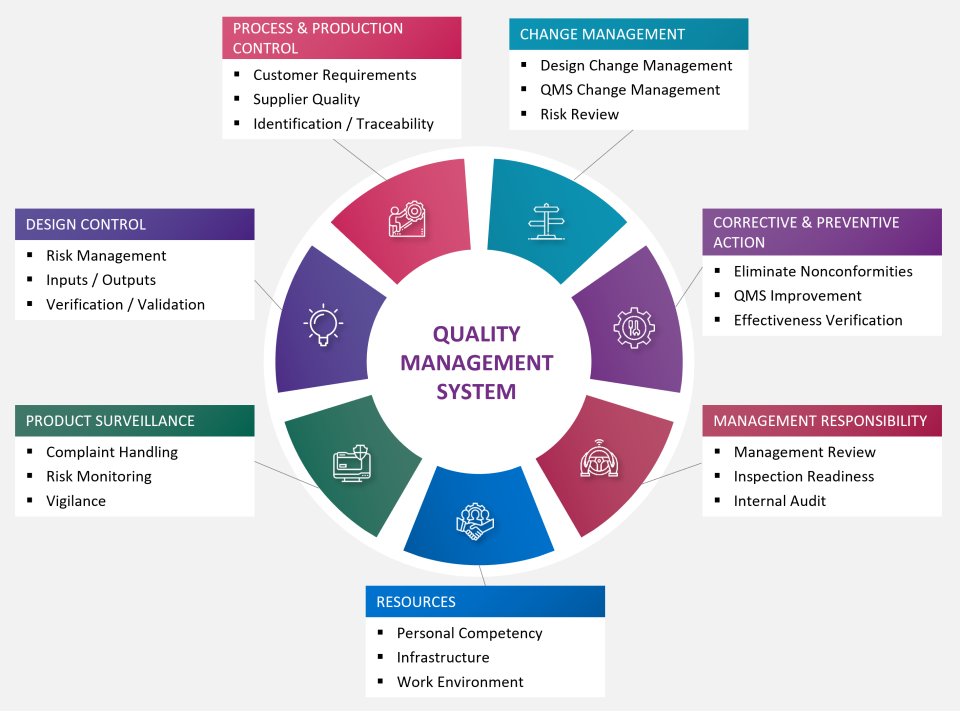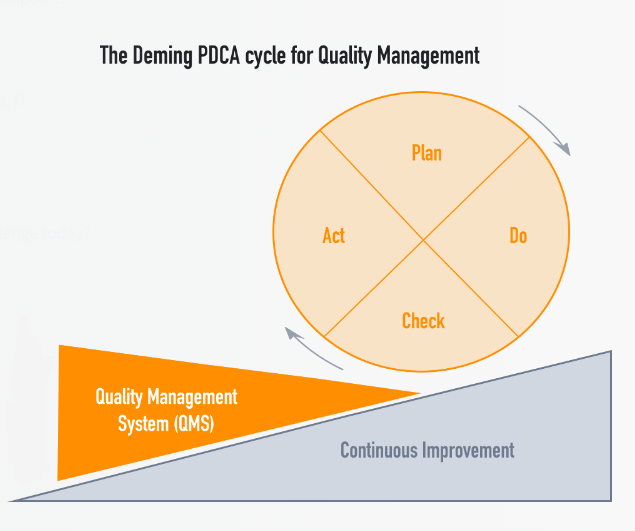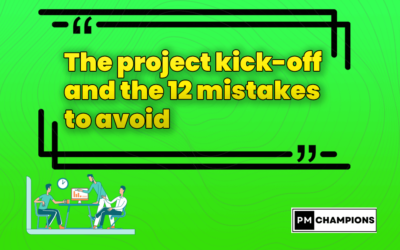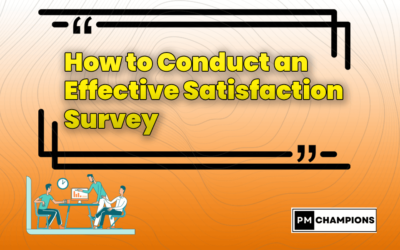“
Quality is remembered much longer than price
“Guccio Gucci
What is quality?

According to the ISO 9000 standard, quality is defined as the ability of an object (product, service, etc.) to meet specific defined requirements.
Quality expectations vary from stakeholder to stakeholder, ranging from concrete to subjective. Thus, different actors will have different criteria for assessing quality. These include:
- Functional Coverage
- Usability
- Maintainability
- Interoperability
- Scalability
- Performance
that influence the perception of a product’s quality.
As for the assessment of the quality of a project, it is based on factors such as on-time delivery, customer relations, budget control, responsiveness, adaptability, advice and satisfaction.
Quality is part of a voluntary approach towards excellence, and is an imperative to comply with requirements, whether they are normative or specified.
Agility:
The Quality Management System (QMS)
Effective project management involves the implementation of a Quality Management System (QMS), in accordance with the ISO 9001 standard, aimed at guiding and controlling quality.
This QMS influences all aspects of the performance of the project and the company as a whole.
The benefits of implementing a Quality Management System are multiple and contribute to value creation, in particular by:
- Achievement of defined organizational objectives,
- Reducing the
risk
of errors and associated costs, - Improved customer satisfaction and employee satisfaction,
- The best promotion of the company’s offers,
- Expansion of market shares,
- Improving internal communication,
- Measuring individual and collective performance,
- Strengthening competitiveness.

The 7 Fundamentals of Quality Management
- Customer focus : Putting customer satisfaction at the heart of our concerns by understanding and anticipating their needs, through communication, satisfaction assessment, etc.
- Leadership : Providing clear direction and creating an environment conducive to employee engagement by setting an example and sharing common values.
- Staff involvement : Every member of the organization must be involved in continuous improvement, understanding their role, being accountable and valued.
- Process approach : define, manage and improve processes by understanding their interactions and monitoring their performance.
- Mutually beneficial relationships: Develop positive relationships with suppliers based on mutual understanding, clear obligations, and regular performance review.
- Continuous improvement: analyze results, identify areas for improvement, set goals, implement change, and formalize improvements on an ongoing basis.
- Evidence-based approach to decision-making : Use reliable and actionable data, such as indicators and dashboards, to minimize decision-making risks .
Key Performance Indicators (KPIs)
They are used to assess the quality of a project and can cover different aspects such as productivity, satisfaction, management, commitment, etc.
However, they must all be defined according to the SMART approach, i.e. they must be Specific, Measurable, Achievable, Realistic and Time-bound.
Some of these KPIs can include:
- Velocity
- The budget gap
- The number of customer complaints
- The number of schedule adjustments
- Business Value
- Team turnover rate
- Percentage of completion
- The rate of “rework”
- Customer and/or employee satisfaction, etc.

The Three Key Steps Regarding KPIs
- Definition : KPIs must be defined at the beginning of the project, during the scoping or initialization phase. This step is essential to ensure the proper collection and use of the necessary data, especially in the dedicated tools. It is also important to agree with the client on the KPIs they want to track.
- Measurement : The use of tools like Jira with its EazyBI module is necessary to visualize relevant data and evaluate KPIs in a synchronized way. The project manager must ensure that he or she has dashboards that allow him to visualize all the KPIs of the project throughout its duration.
- Reporting : KPIs are used as part of project reporting during internal and external governance bodies (steering committees, strategy committees, quality reviews, etc.). Depending on how the KPIs evolve, actions can be taken to correct any discrepancies.
Quality Management Tools

The PDCA (Plan-Do-Check-Act):
is applicable to all contexts, including projects. It consists of four successive phases: Plan, Act, Check and Adjust. This sequence allows for continuous improvement: the planning of objectives, means and
risks
, the implementation of plans, the verification of the achievement of objectives, the evaluation of performance and the capitalization of past experiences.
The Quality Management System (QMS) consolidates the lessons learned from previous experiences and promotes the evolution of the wheel, while the steering drives the movement.
Process approach : According
to ISO 9001, a process is defined as a set of interrelated or interacting activities that transform input elements into output elements. Typically, the input elements of one process are the output elements of other processes.
Processes are grouped into three categories:
- Management or steering processes,
- The business processes that carry out the services,
- The supporting processes that provide the necessary means.
The process approach consists of describing the processes involved in a project in a holistic way in the form of workflows, representing logical and chronological sequences of key steps. For example, this can include the process of creating a project or managing issues in Jira.
This approach makes it easier to identify defects and areas for improvement. By associating key performance indicators (KPIs) with processes, such as costs and deadlines, it becomes possible to measure their impact and optimize their operation.
Control and Monitoring Plan: The principle of this plan is based on a complete inventory of all control and surveillance actions implemented within the framework of a project. This includes activities such as project check-ups or code reviews. Project governance is also integrated into this process.
These actions are described in detail, including:
- Who is responsible for making them happen?
- When do they come into play in the project cycle?
- What is the scope of control?
- What tools are used?
- How are the results formalized and reported?
- Who is the recipient of the results?
These actions are listed in a reference document, such as a Quality Assurance Plan (QAP) or, failing that, a Project Plan. They are carried out throughout the project and are monitored either by means of a specific monitoring document or by Minutes attesting to their completion. It is important to detail the action plan resulting from the observations made and to ensure that they are subsequently processed.
The Test Strategy
is an essential element for any digital project, bringing together instructions, guidelines and principles that frame the testing process.
It clearly defines the process that the project team must follow to achieve the set objectives, i.e. the “how”.
This document is usually developed by the project manager in collaboration with the main stakeholders of the project.
The Test Strategy document details all the tests to be carried out as part of the project, including:
- Manual testing (compliance testing, release testing, non-regression testing, etc.)
- Automated testing (static testing, API testing, load testing, security testing, etc.)
The details of “what” and “who” perform the tests are specified in a companion document called the Test Plan.
The latter is usually produced by the QA (Quality Assurance) function, i.e. the project’s test manager or QA tester.
The Test Plan specifies the modules to be tested, the types of tests for each, the test managers, etc.
The Quality Assurance Plan (QAP):
is an essential reference document produced at the beginning of the project, usually at the explicit request of the client, but it is highly recommended for all projects. What is it for? Because the QAP meticulously details all the measures taken to guarantee the quality of the service. It therefore serves as a normative framework for the company and provides additional assurance to the customer.
The QAP addresses a number of themes, including:
- The organization of the project,
- The roles and responsibilities of the various stakeholders,
- Project governance, including committee structures and escalation processes,
- Key Performance Indicators (KPIs), Service Level Agreements (SLAs) and associated measurement mechanisms,
- Key processes such as testing and risk management processes,
- Managing unforeseen events and changes,
- Management of project deliverables and documents,
- Tools used for quality management, etc.
The QAP is a standard deliverable for all types of projects and must be validated by the client.








0 Comments